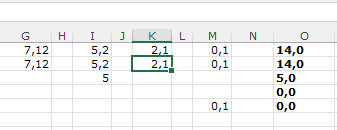The formula in column O is not behaving the way it is supposed to. Can someone please check and be able to tell me why it is not working for me? The formula is supposed to sum the whole part and the decimal part of the number separately and then present the result separated by a comma. Somehow, when I try it, it is not showing the decimal parts of the sum. Please help!
This is what I'm getting:
| Cell Formulas | ||
|---|---|---|
| Range | Formula | |
| O1:O5 | O1 | =(TRUNC(G1,0)+TRUNC(I1,0)+TRUNC(K1,0)+TRUNC(M1,0))&","&IFERROR(VALUE(MID(G1-TRUNC(G1,0),FIND(".",G1-TRUNC(G1,0))+1,256)),0)+IFERROR(VALUE(MID(I1-TRUNC(I1,0),FIND(".",I1-TRUNC(I1,0))+1,256)),0)+IFERROR(VALUE(MID(K1-TRUNC(K1,0),FIND(".",K1-TRUNC(K1,0))+1,256)),0)+IFERROR(VALUE(MID(M1-TRUNC(M1),FIND(".",M1-TRUNC(M1))+1,256)),0) |
| Cells with Conditional Formatting | ||||
|---|---|---|---|---|
| Cell | Condition | Cell Format | Stop If True | |
| G1:N2,O1:P5 | Cell Value | =0 | text | NO |
This is what I'm getting:






